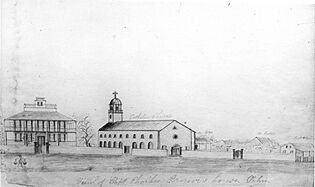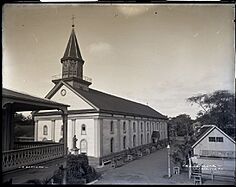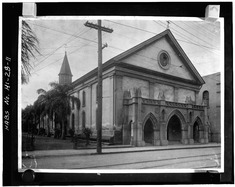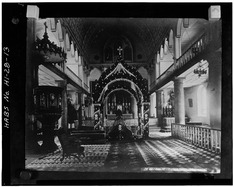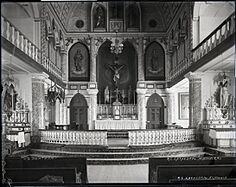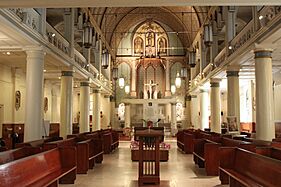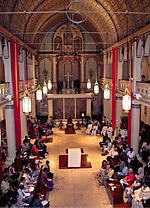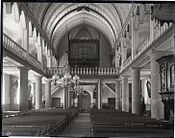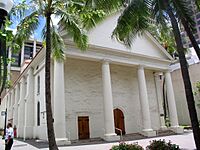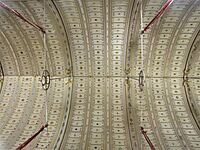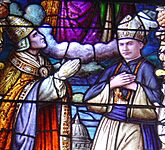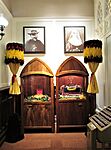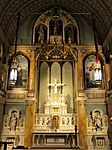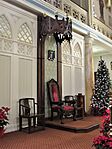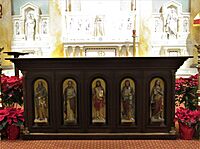Cathedral Basilica of Our Lady of Peace facts for kids
Quick facts for kids Cathedral Basilica ofOur Lady of Peace |
|
|---|---|
| French: Cathédrale de Notre Dame de la Paix Portuguese: Catedral de Nossa Senhora da Paz Hawaiian: Malia o ka Malu Hale Pule Nui Latin: Basilicæ cathedralis Sanctæ Mariæ de Pace |
|
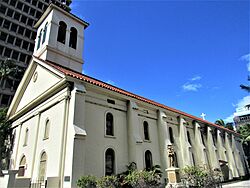
Façade from the North
|
|
| 21°18′39″N 157°51′34″W / 21.31075°N 157.859417°W | |
| Location | 1175 Fort Street Mall Honolulu, Hawaii |
| Country | United States |
| Denomination | Catholic |
| History | |
| Status | Cathedral Minor basilica |
| Dedicated | August 15, 1843 |
| Relics held | Sts. Damien de Veuster & Marianne Cope |
| Architecture | |
| Functional status | Active |
| Architectural type | Basilica |
| Style | Romanesque Revival, Gothic Revival |
| Groundbreaking | July 9, 1840 |
| Completed | August 15, 1843 |
| Specifications | |
| Capacity | 600 |
| Length | 155.4 feet (47.4 m) |
| Width | 51.3 feet (15.6 m) |
| Materials | Coral, marble, plaster, terra cotta, Acacia koa |
| Bells | 2 ("Maigret" & "Aubert") |
| Administration | |
| Diocese | Honolulu |
| Province | San Francisco (Region XIII) |
The Cathedral Basilica of Our Lady of Peace is a very important church in Honolulu, Hawaii. It is the main church for the Catholic community there. It is also known as a cathedral and a minor basilica.
Contents
History of the Cathedral
Building the First Church
The first Catholic missionaries arrived in Hawaii from France in 1827. They held their first Mass in a simple grass hut. With help from a Hawaiian chief, they got land and built the first Catholic church in Hawaii in 1828.
However, for about ten years, Catholic priests were not allowed in Hawaii. This was a difficult time for Catholics. In 1839, the Hawaiian government finally allowed religious freedom. As a way to make up for the past, King Kamehameha III gave the missionaries land and money to build a new, bigger church.
Construction for this new church began on July 9, 1840. This date was special because it was the Feast of Our Lady of Peace. Many native Hawaiians helped build the church by collecting coral blocks from the shores. The church was finished and officially opened on August 15, 1843.
Changes Over Time
Over the years, the Cathedral of Our Lady of Peace has been updated many times. When Louis Désiré Maigret became the bishop, he added a wooden spire and a large bell. He also bought a special chair for the bishop, called a cathedra.
In the 1870s, the church got a new, higher roof and a beautiful vaulted ceiling. New stained glass windows were added, and statues of saints were placed above the main area. A fancy marble altar was also installed. Bishop Maigret worked for 35 years to make the church look more like European churches.
Later, in 1893, a large bronze statue of Our Lady of Peace was added. In the early 1900s, Bishop Libert H. Boeynaems wanted to make the church look more Gothic. He added a detailed porch in 1910. However, this plan was too expensive to finish. Instead, the wooden floors were replaced with cement, and the wooden spire was replaced with a concrete bell tower.
In 1926, Bishop Stephen Peter Alencastre decided to give the cathedral a Romanesque revival style. The Gothic porch was replaced with doric columns. New stained-glass windows from Germany were installed. Italy even gave a new Carrara marble altar as a gift. In 1940, steel supports were added to make the building stronger.
Changes After Vatican II
In the 1950s and 1960s, after a big meeting called the Second Vatican Council, many churches around the world made changes. Bishop James Joseph Sweeney made changes to the Cathedral of Our Lady of Peace. The communion rails were removed, and a new altar was built so the priest could face the people during Mass. The tall pulpit was replaced with a simpler lectern. Wood from the koa tree was used for parts of the church walls and doors.
Recent Updates
The cathedral became too small for the growing number of people. So, in 1984, Pope John Paul II made Saint Theresa Catholic Church a co-cathedral. This meant Honolulu had two main Catholic churches.
In 1993, the church layout changed again. The pews were moved to face each other, and the altar was placed in the middle. A special area for prayer was created near the tabernacle.
More recently, starting in 2010, a big project began to make the cathedral look like it did in the late 1800s. This included adding replica paintings of the Stations of the Cross and new chandeliers. A new chapel is also planned to hold special items, called relics, from Saint Damien and Saint Marianne.
By 2018, for the church's 175th anniversary, the altar was moved back to the front. The pews were also turned to face the altar again. Pillars were repaired and painted to look like marble. New paintings of Saints Damien and Marianne were added to the sanctuary wall.
Why This Church is Important
The Cathedral Basilica of Our Lady of Peace has a very important place in the history of Hawaii. It reminds us of the religious changes that happened in the Hawaiian Kingdom long ago. It shows how the Catholic Church eventually became accepted.
This church is also special because:
- Saint Damien, a famous priest who helped people with leprosy, became a priest here in 1864.
- Saint Marianne Cope, who also helped people with leprosy, began her work in Hawaii from this church in 1883.
- It is the oldest building still standing in the downtown area of Honolulu.
- It was added to the Hawaii Register of Historic Places and National Register of Historic Places in 1972.
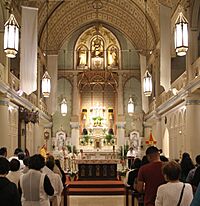
The Cathedral Basilica of Our Lady of Peace is believed to be the oldest cathedral in the United States that has been used continuously.
Burials at the Cathedral
Bishop Louis-Désiré Maigret, who made many improvements to the church, was buried under the sanctuary of the cathedral in 1882. His tomb was found during renovations in 1981.
Another bishop, John Joseph Scanlan, was also buried near Bishop Maigret in 1997. There are now four more spaces for future bishops to be buried there.
The remains of Saint Marianne Cope were brought to the cathedral in 2014. They are kept in a special container, called a reliquary, near the sanctuary, next to a relic of Saint Damien.
Becoming a Minor Basilica
On May 10, 2014, Pope Francis gave the Cathedral the special title of Minor Basilica. This title is given to churches that are very important. It came with special symbols: a ceremonial canopy called an umbraculum and a ceremonial bell called a tintinnabulum. These were shown for the first time at a special Mass on October 11, 2014.
The Pipe Organ
The first pipe organ in the cathedral came from France shortly after the church was built. A second, larger organ was installed in 1885. It was a gift from a church member. A large statue of Saint Cecilia, who is the patron saint of music, was placed in front of this organ in 1906.
The current organ, installed in 1934, is very impressive. It has 3 keyboards, 37 stops (which control different sounds), and 2,159 pipes! It was blessed in a special ceremony and its first concert was even broadcast on the radio.
The Church Campus
The Cathedral building is part of a larger area owned by the Diocese of Honolulu. This land was bought a long time ago, during the time of the Kingdom of Hawaii. In the past, parts of this land were used for a school.
Today, the campus includes the Diocesan Chancery, which is where the bishop's offices are. It also houses the Hawaii Catholic Herald newspaper. The same building has the rectory, which is where the priests who serve the Cathedral live and work.
Some parts of the campus are rented out to businesses. For example, the Century Square building, a modern skyscraper, has offices and apartments. There are also plans to build new affordable homes for seniors where the old parish hall used to be. Underneath the campus, there is a large underground parking lot that was once a freshwater well dug by early missionaries.
Gallery
-
Figures of Jesus and saints on the altar, which were once part of the pulpit
-
The main doors of the bishop, made of koa wood
See also
 In Spanish: Catedral de Nuestra Señora de la Paz (Honolulu) para niños
In Spanish: Catedral de Nuestra Señora de la Paz (Honolulu) para niños


